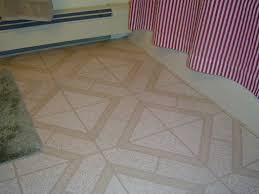Step-By-Step Instructions for Making Your Own Vinyl Flooring Repair
By Mark J. Donovan
|
|
Did you try your luck once too many with dragging the kitchen appliances across your vinyl floor? Did you drop a knife, blade first, into your vinyl flooring and dirt just keeps causing the split to show? Well you don’t have to live with the damaged vinyl flooring. You can make your own vinyl flooring repair using a couple of basic tools and a small swatch of left over vinyl flooring.
If you don’t have a swatch of left over vinyl flooring, then contact the store where you purchased the vinyl flooring, to see if they still carry the same vinyl flooring pattern. Also, check underneath the stove area. Often there is a large enough section of vinyl flooring that you can cut away a section of it and use it for the vinyl flooring repair. |
If you are unable to find any spare vinyl flooring material then you’ll have no choice but to either live with the vinyl damage or replace the entire vinyl floor.
How to Repair Damaged Vinyl Flooring
First measure the size of the damaged vinyl floor area. Record the width and length of the damaged area by encompassing the damage in effectively a square or rectangle perimeter.
Second, cut a swatch of the vinyl flooring material slightly larger than the measured area using a very sharp utility knife. Use a level or straight edge to keep straight lines while making your cuts.
Seventh, remove the damaged vinyl flooring piece that you cut out. You may need to use your utility knife to lift the piece out. Also, a hairdryer can help to soften the vinyl flooring adhesive and make it easier to remove the damaged vinyl flooring piece.
Eighth, use a putty knife to scrape away the old adhesive. Then vacuum the spot. You want to make sure the area is completely free and clean of old adhesive and debris.
| Ninth, apply vinyl flooring adhesive to the back of the vinyl flooring swatch that you cut using your putty knife. Make sure the room is well ventilated when using vinyl flooring adhesive. It has strong and unhealthy fumes.
Tenth, place the vinyl flooring patch into the cut out area in the vinyl floor. Press it into place by working in the center of the patch and working your way outwards. I find a pizza roller works great for doing this part of the vinyl flooring repair. Eleventh, wipe up any excess adhesive that may have squirted out around the edges and seams with a damp rag or sponge. |
 |
Twelfth, again use your pizza roller to work the patch into place and wipe away any residual adhesive that may again ooze out. Really concentrate on the seam areas of the patch with the roller during this step.
Lastly, allow the adhesive to fully dry for 24 hours before walking on the area. And that’s it. You’ve completed your own damaged vinyl flooring repair job!
For help on finding a wood flooring installation contractor, see HomeAdditionPlus.com’s Wood Flooring Installation Bid Sheet. It will help ensure that you find and hire the right flooring installation contractor for your wood flooring project. In addition, it will help to ensure that your wood floor installation is completed on time and on budget.
Related Information
- Installing Vinyl Tile Flooring
- Why Testing Subfloor Moisture Levels is Important
- How to Remove Vinyl Flooring
Additional Flooring Resources from Amazon.com
 |
 |
Free Home Addition Price Quotes with No Obligation!
Fill out our 3-5 minute quick and easy form, and receive a free price quote on a house addition from one of our prescreened and licensed home addition contractors. This process is free and there is no obligation to continue once you receive your house addition price estimate.

